In tennis, doubles is a very different and more complex game than singles. The court is bigger, there are more players on the court, you typically spend more time at the net, and points are generally shorter.
When creating a tennis doubles strategy for your team, there is a lot to consider. Below you’ll discover proven strategies, tips, and tactics so you can become a better doubles player, frustrate your opponent, and win more tennis matches.
You should have a primary strategy that works well for you in most matches based on you and your partner’s strengths. You will also have to adjust the strategy based on how your opponents play.
For example, maybe you’re a serve and volley doubles player, but you may come up against a team that hits really low returns that give you a difficult volley. In this case you might want to stay back for the first shot after the serve before coming in.
6 Basic Tennis Doubles Strategies
Below are common strategies you can use in your tennis match for different situations.
1. Take Over the Net
This strategy is common among professional doubles tennis players like the Bryan Brothers. You often see points where both players end the point only a few feet away from the net.
New Course!
The Mental Game Masterclass
The Mental Side of Doubles You Were Never Taught
- Perform better under pressure
- Beat more talented players
- Come out HOT early in matches
- Avoid mid-match slumps
- Become your own coach

I guarantee this will transform the way you prepare for your next doubles match.
Will Boucek – ATP & WTA Doubles Strategy Analyst
If you can take over the net consistently in a doubles match, you will put pressure on your opponent. You can force them on their heels, and make them try to hit difficult low percentage shots. Volleys close to the net are usually easier shots as well, so you’ll win more points. You have better angles at the net, and you can smash the ball down into the court.
2. Move Side to Side at the Net
You should always be using this strategy at the net in doubles. Moving laterally at the net, especially when your opponent is about to hit a groundstroke, will put pressure on them. Tennis players are taught to not hit to the net player in doubles so they will likely try to change the direction of their shot, or hit a more difficult shot. This can cause countless unforced errors and frustrate the other team. If you are faking (see below) you may also get an easy volley to win the point.
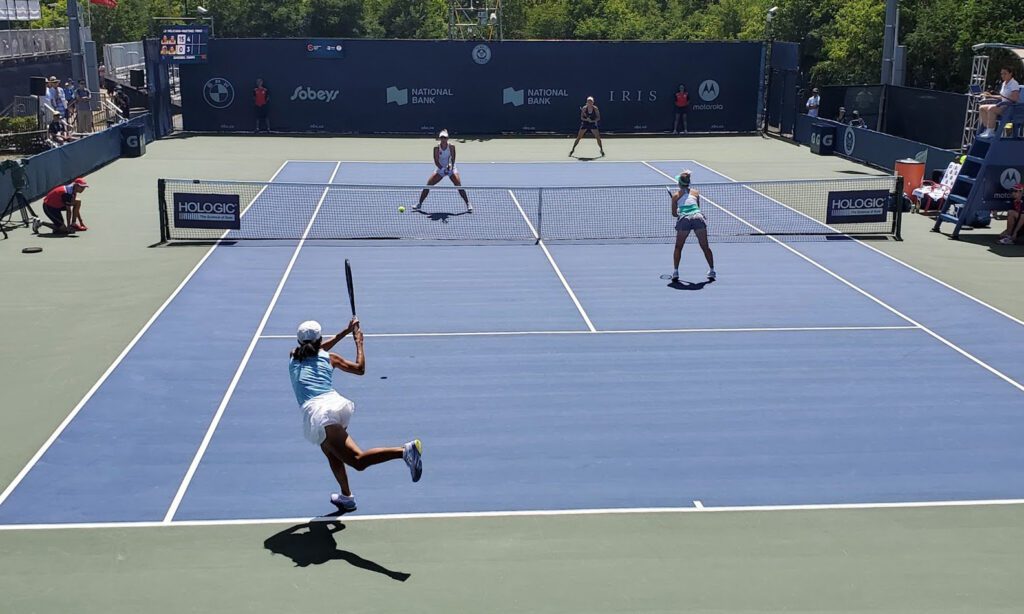
3. Hit the Ball to the Net Player’s Feet
It is much more difficult to hit a good volley from down low by your feet or ankles than a volley up high at your chest or shoulders. Hitting the ball at their feet puts the opponent at a big disadvantage. They will usually miss the shot or pop the ball up since they have to lift a difficult volley back up over the net. This is usually a good time for you or your partner to poach and put the ball away.
You can get the ball to their feet by hitting heavy topspin on your groundstrokes to get the ball to dip at the opponent’s feet. Another tactic is to hit a soft volley that stays low over the net before dropping to the opponent’s feet.
4. Hit Groundstrokes Deep in the Court
When you’re returning or hitting groundstrokes, try driving the ball deep in the court to push the opponent back. This will allow you to charge forward for the next shot. Typically the opponent hits a weak shot because you’ve forced them on their heels behind the baseline. This also gives you time to attack from the net. I like to do this with my forehand, aiming for the deep corner near the doubles alley.
COURSE
Net Play Strategy for Doubles
Masterclass on skills, strategy, and mindset for dominant net play in doubles!
- Over 190 minutes of Video Doubles Lessons
- 25 Whiteboard Video Lessons
- Video Analysis of over 30 ATP & WTA doubles points
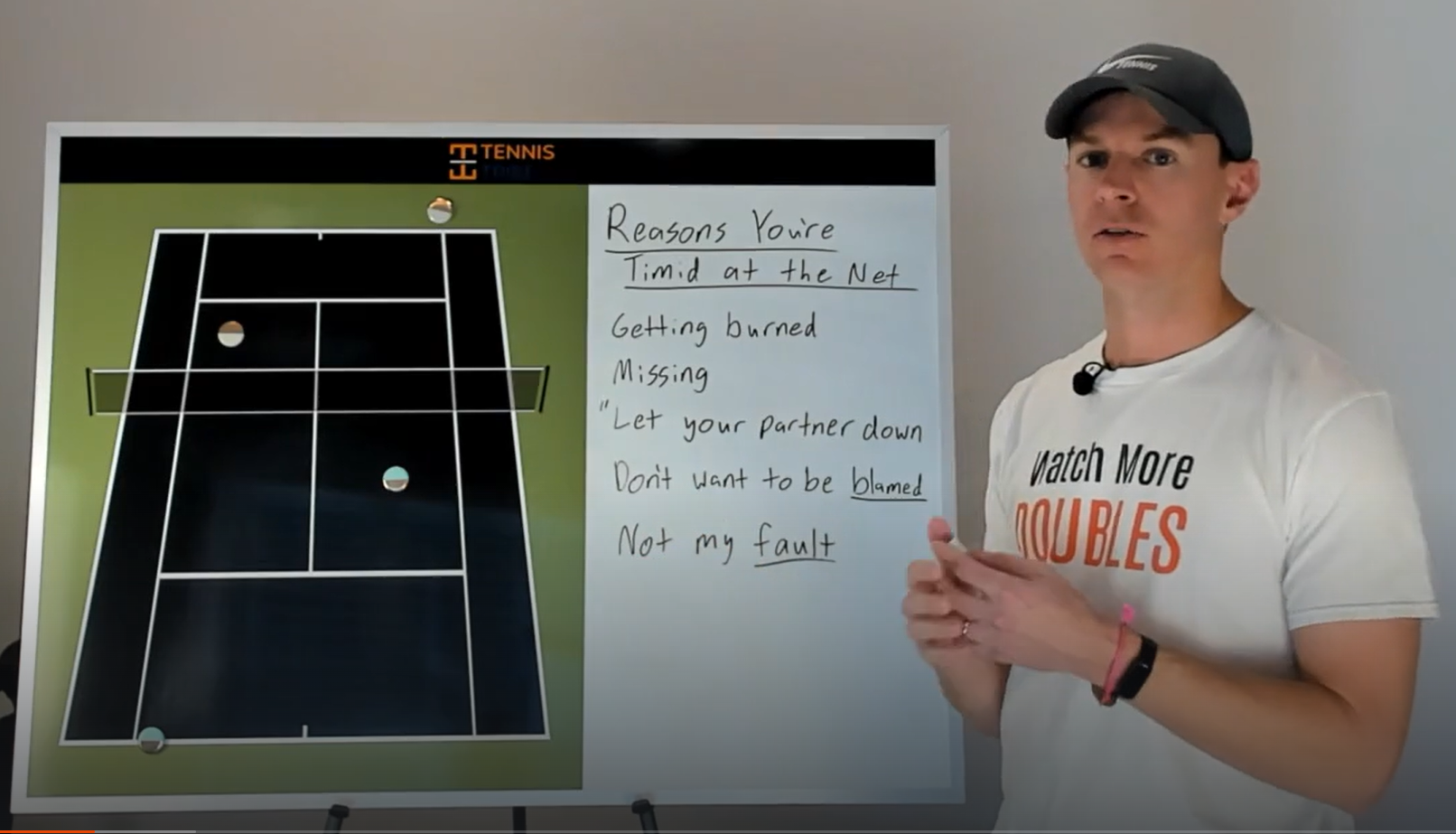
You’ll learn from Will Boucek, an ATP & WTA Doubles Strategy Analyst
5. Attack the Middle of the Court
One of my college tennis teammates used to say “down the middle solves the riddle.” This is a great doubles strategy, especially if both opponents are at the net. There are several advantages you get from attacking the middle of the court in doubles.
- You are forcing the other team to communicate, and potentially causing confusion. Usually, the opponent with the forehand in the middle will take these shots. If one opponent is left-handed and the other is right-handed, then this can be even more effective.
- You are taking away the angles of their next shot. From the middle of the court, the opponent has smaller angles to use. This is a good time for you and your partner to pinch the middle since they’ll have trouble passing you wide.
6. Hit to the Weaker Player’s Backhand Volley
Almost every doubles player has a weaker backhand volley than forehand volley. If you can hit a hard, or low shot at the backhand volley of the weakest opponent, you will likely make them miss or get an easy next shot. When both players are at the net, this should be the default shot unless another obvious shot is better.
Tennis Doubles Positioning & Formation Strategies
In tennis, doubles positioning is highly underrated by recreational and competitive players. I see way too many people standing too close to the doubles alley or too far back from the net. In general, there are several guidelines you should follow when considering your doubles positioning on the tennis court.
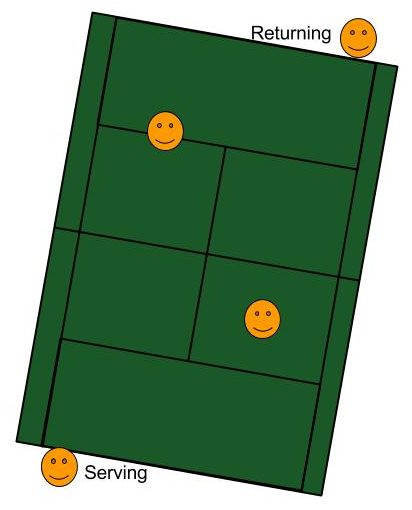
- When your partner is serving or returning stay halfway between the center line and the doubles alley.
Starting too far in the alley will take pressure off your opponents, making their return of serve (or groundstrokes) much easier since they have a larger court to hit to. - While your partner is serving or hitting a groundstroke, stand halfway between the net and service line (or closer).
If you stand too far back at the net, then you will make your volleys difficult because they will drop too low. You should always try to hit volleys at your waist or higher if you can. - At the net, you should move forward and backward.
While your partner is hitting you should be back closer to the service line. As you see the ball go across to the other side of the net, you should move forward closer to the net so you have an easier volley if they hit at you (Unless your partner gave them an overhead. In that case, bail!). You can use your positioning and movement to help with your volley technique. - The returner and server should stand within 2-4 feet of the doubles alley.
You’re responsible for covering half of the court so you should usually start close the middle of your half. The exception is for certain advanced doubles formations, covered below.
You’ll also see several different formations in doubles, especially from the serving team. Below, I will break down the advantages, disadvantages, and strategy of each of the most common doubles formations.
MOST POPULAR COURSE!
25 Winning Doubles Tactics
Guaranteed to help you play smarter & win more matches.
- Over 50 video doubles lessons
- 60+ ATP & WTA points analyzed
- Nearly 3 hours of strategy content
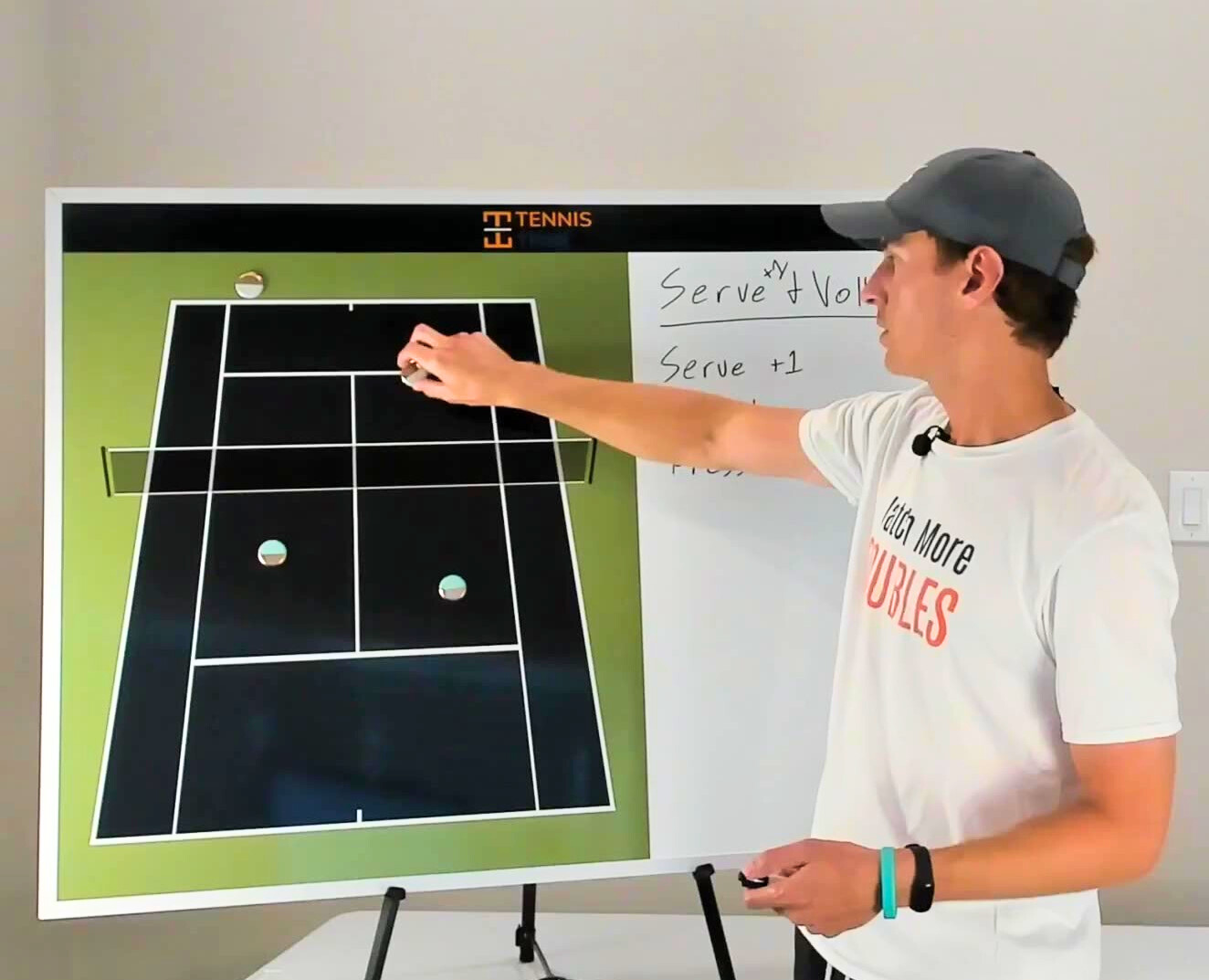
Will Boucek – Doubles Strategy Analyst for ATP & WTA Players and Team USA at the 2024 Olympics
Standard Doubles Formation
The standard formation in doubles is one person at the net, and one person back for both teams. This is the most common, and is the best option in most cases. The net players are crosscourt from each other. This allows the baseliners to hit deep, more consistent groundstrokes crosscourt.
Advantages: Using this formation allows your team to have someone covering the lob, and someone ready to attack any weak shots from the net. It also allows the baseline player more room for error since they’re hitting a crosscourt shot.
Disadvantages: Timid net players will tend to not get involved with this formation. This is a bad thing since you always want your opponent to have to go through the net player. Also, if you’re playing a good team, they can get in a rhythm if you stick to the standard formation because you’re giving them the easy crosscourt shots.
When to use it: I recommend use the standard doubles formation 75-90% of the time, and add different looks below to keep the other team off balance. The exception is if you find a glaring weakness from the other team that makes a different formation consistently more effective.
Doubles Serving Strategy: The I Formation
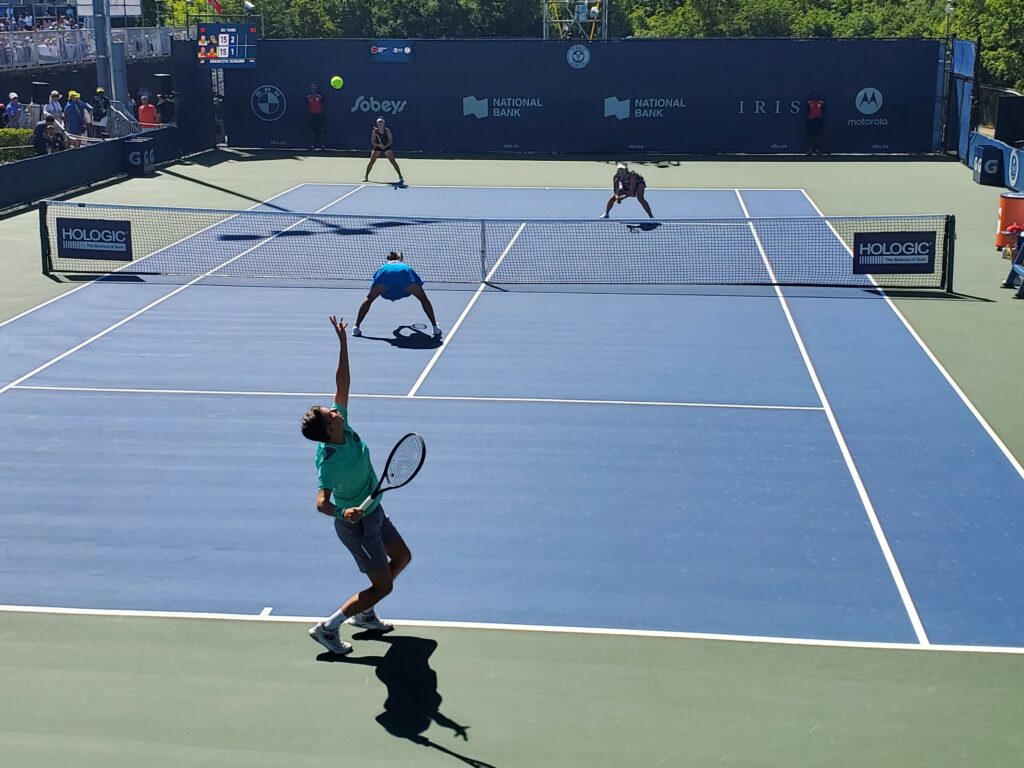
The I formation is when the net player and the server form something close to an I. The net player will stand on, or close to the center service line. The server will stand close to the middle as well. The server and partner will communicate before the point to determine which direction each player will move after the serve. This is often done with hand signaling.
Advantages: The returner does not know where the net player will move. This puts pressure on the returner to hit a good return. You can force a lot of missed returns with this formation.
Disadvantages: If the returner hits a good down the line shot, it will likely be a winner or put your team off balance.
When to use it: If a returner is getting into a rhythm while you’re using the standard formation, try the I formation to give them a new look. I don’t recommend using this the whole time in a match, but feel free to try it in 3-5 times per set.
EVERYTHING you need to break serve!
Download My Free Return Strategy Cheatsheet >>>
Doubles Serving Strategy: Australian Formation
The Australian doubles formation is when the server and the net player both stand on the same side of the court, leaving an entire half of the court open.
Advantages: If the returner has a weak down the line return, this can be used to force them into that low percentage shot causing a lot of errors.
If you use this on the ad side, the server will have forehand groundstrokes (assuming they are right-handed).
Disadvantages: You are leaving an entire half of the court open. A hard down the line return could be a winner unless the server is very fast.
When to use it: There are two good times to use this formation.
When one of your opponents is hitting really strong crosscourt returns, and you’re losing most of those points. The Australian formation will force them to go down the line which is a more difficult return. When the server feels much more comfortable hitting groundstrokes from one half of the court. I, for example, have a weaker backhand, so I could do this on the ad side to force the opponent to return the serve to my forehand side.
See more advanced strategies for doubles positioning on my youtube channel where I break down USTA doubles matches.
Developing a Serve Strategy for Doubles
When considering a serving strategy for doubles, you want to do your best to set up your net player with easy volleys. The best way to do this is to find the opponent’s weakness on their return.
Most people have a weaker backhand than forehand, so it’s typically best to serve up the T on the deuce side and wide on the ad side. Don’t worry about hitting aces, just get it to the backhands so your net player can get themselves involved.
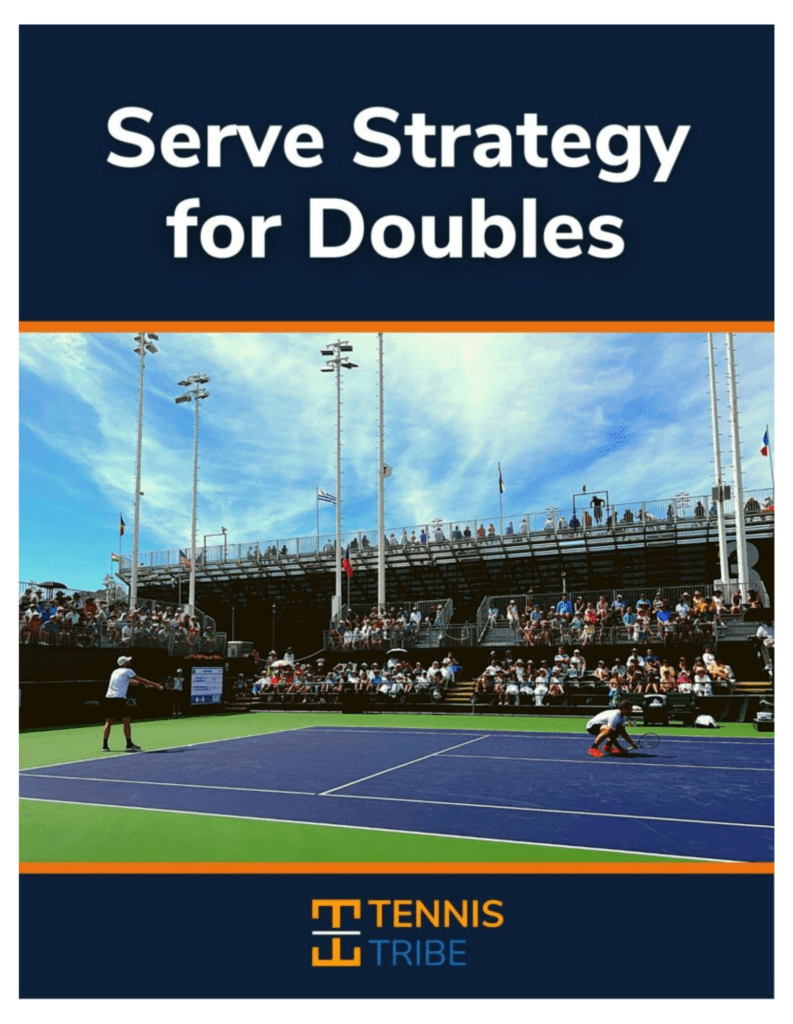
This 55-page Ebook includes EVERYTHING you need to know
Serve Tactics Guaranteed to Make Holding Serve Easy
Learn to hide your weaknesses, force return errors, and create game plans with your doubles partner to hold serve more often.
As you progress through the match, stay aware of how the opponents are handling each serve. Here are a few questions to ask yourself.
- Do they like their forehand or backhand better?
- Are they more comfortable with fast pace or slower serves?
- Can they hit the return down the line, or is every ball crosscourt?
Answering questions like these will help you develop a more effective strategy throughout the match. You can continue to make your opponent more and more uncomfortable by attacking their weaknesses while serving.
Listen to our podcast episode below all about serve strategy for doubles.
Return Team Strategy for Doubles
The ability to return in tennis matches and break serve can help you take your doubles game to the next level.
However, there is nothing more satisfying for your opponents than you missing a return. This is why it’s important to focus on making a high percentage of solid returns. Giving away free points on the return can let a match get away from you quickly.
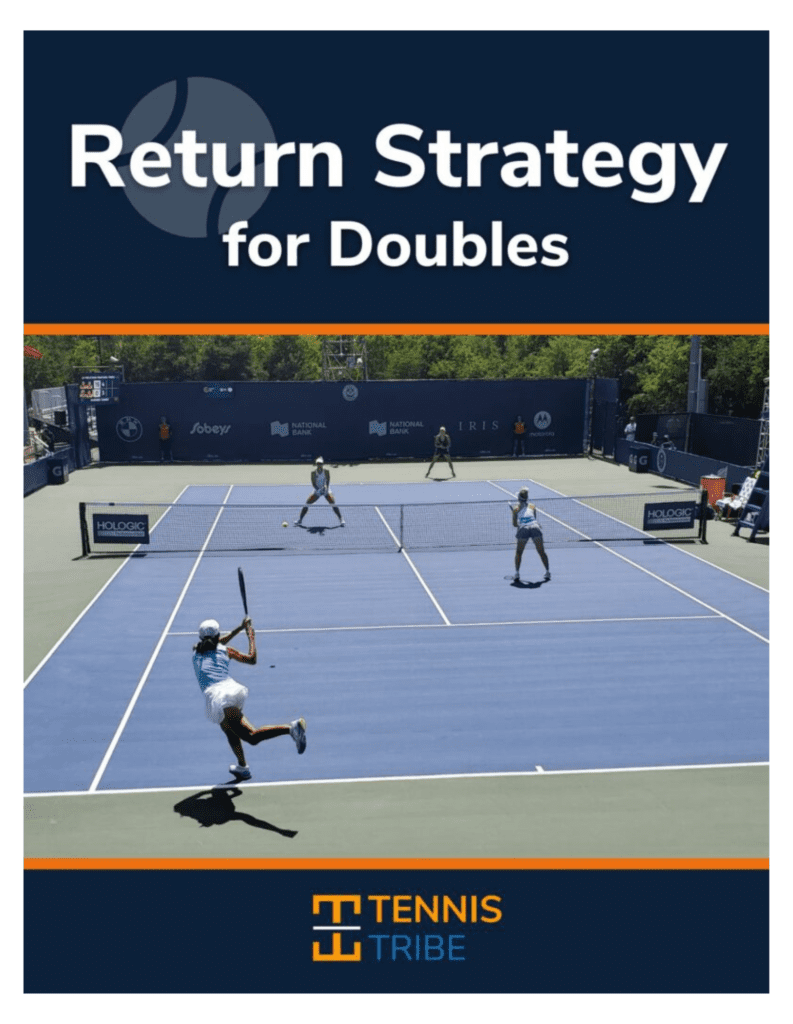
This 71-page Ebook will skyrocket your return game
Proven Return Strategies Against Any Type of Server
EVERYTHING I know about return strategy. I teach this information to 3.0 club players and ATP/WTA top 10 doubles teams.
Don’t go down the line (too much) or worry about the net player poaching. Trying to go for too much on the return is a huge mistake that many players make. By simply make returns consistently you will win return games because eventually the opponents will miss a few volleys or groundstrokes and lose a game.
Aim for the Middle Net Strap
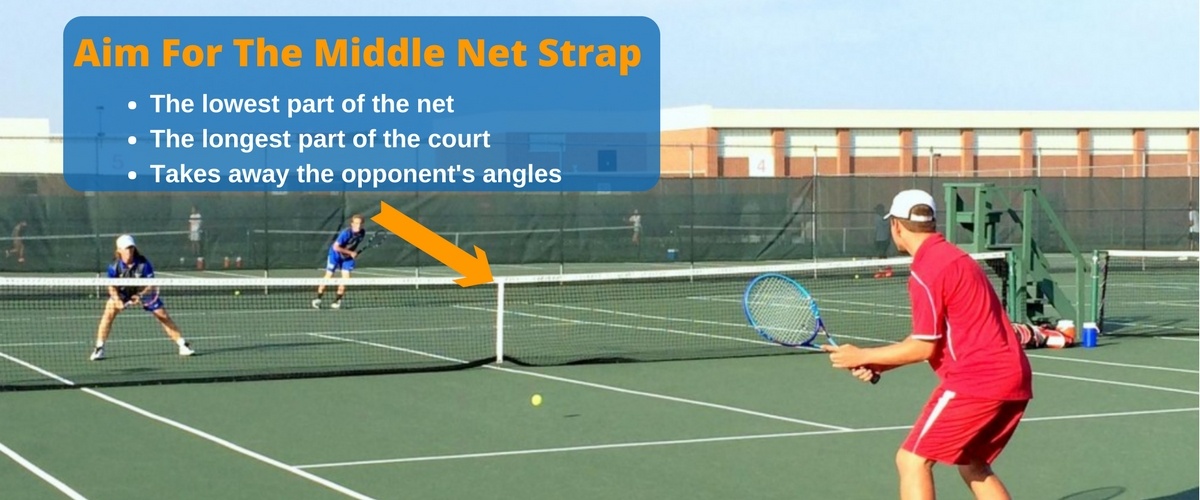
It is the lowest part of the net, so you have more room for error. It also makes for a difficult volley for the net player and takes away their angles if they do poach.
Against a team that plays well at the net, you’ll want to keep the returns low. They will have a more difficult volley and likely pop the ball up. If the server stays back, and the net player is timid, then you can hit returns deep crosscourt. As discussed above, this makes for a tough groundstroke so your teammate can poach.
Listen to our podcast episode below about return strategies for doubles.
Three Net Strategies for Doubles
You will be at the net a lot in doubles, so it’s very important to have an effective net strategy.
A common misconception in doubles is that you have to either poach or cover the line at the net. Really, you should always be moving at the net.
If you’ve ever told your partner, “I’ll cover the alley,” then you’re doing it wrong.
There are three options you have as the net player… poach, fake, or pinch. I’ll show you how to execute each one below.
Poaching in Doubles
A poach in tennis is when the net player crosses towards the other side of the court to cut a ball off and hit a volley.
I typically recommend poaching early in the match. Most players never return down the line early in a match so you should be able to poach a few returns during the first few games. If your partner can serve to the backhand, the return should be fairly weak. Be sure to close towards the net, and hit the volley at its highest point when you poach.
Poaching can also be done during a rally. Anytime you see the opponent in an uncomfortable position, like on their heels behind the baseline, poaching can be an effective strategy.
The Fake
The fake is when you act like you’re going to poach, but you recover towards the alley in the service box.
One of the best ways to force missed returns or groundstrokes is to fake. If we’ve poached a few times in the match already, maybe they hit a few shots up the line, or tried a lob. This is a great time to counter with a fake.
Leave super early and get to the middle of the net as the serve crosses. Then just before the opponent makes contact with the ball, jump back to your side to put away the volley that’s sure to come down the line. A lot of times, they’ll just miss but other times you’ll get a pretty easy volley.
The Pinch
Pinching is when you move diagonally towards the center net strap. In this case, you are giving up a little bit of the alley, but you’re also taking away some of the crosscourt shot.
Pinching is a great tactic to force the opponent to hit an uncomfortable shot into a smaller target. If they hit a weak return crosscourt, you’ll be there to put it away. To get it by you down the alley, their return or groundstroke has to be within a few feet of the sideline, especially on a serve is up the T. This will make them miss often, and will get you involved in the point as a net player. Anytime I’m not poaching or faking, I’m pinching.
The alley is open on two of these three options when my partner is serving (all but the fake). That’s intentional because I want the opponent to go for that lower percentage shot, and increase my odds of closing the point out at the net by getting more involved.
The Key To Effective Doubles Strategy
The key to all of these tennis doubles strategies is to stay active at the net and make your opponent hit uncomfortable shots. Between every shot, we should be creating some movement to force the opponent to think about where to hit. Never let them into a rhythm, and change up the looks you’re giving them. Test different strategies out, and work with your partner to see what works best for your team.
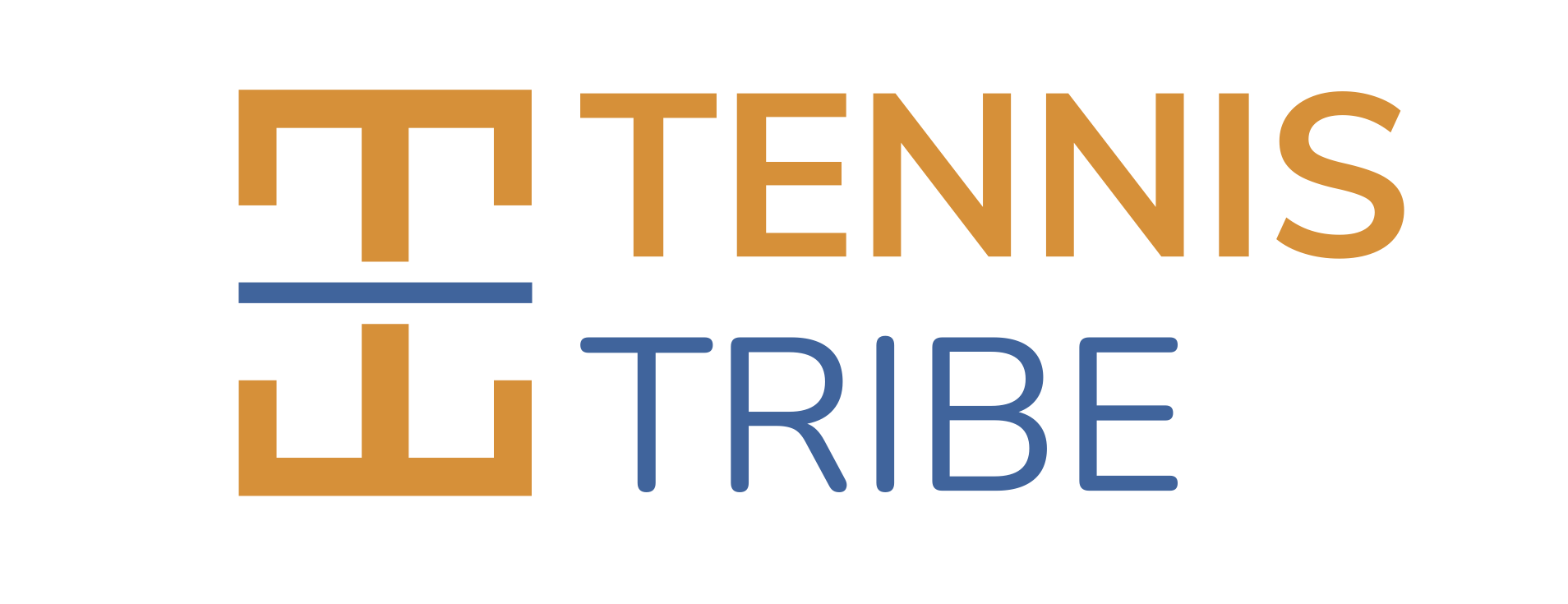
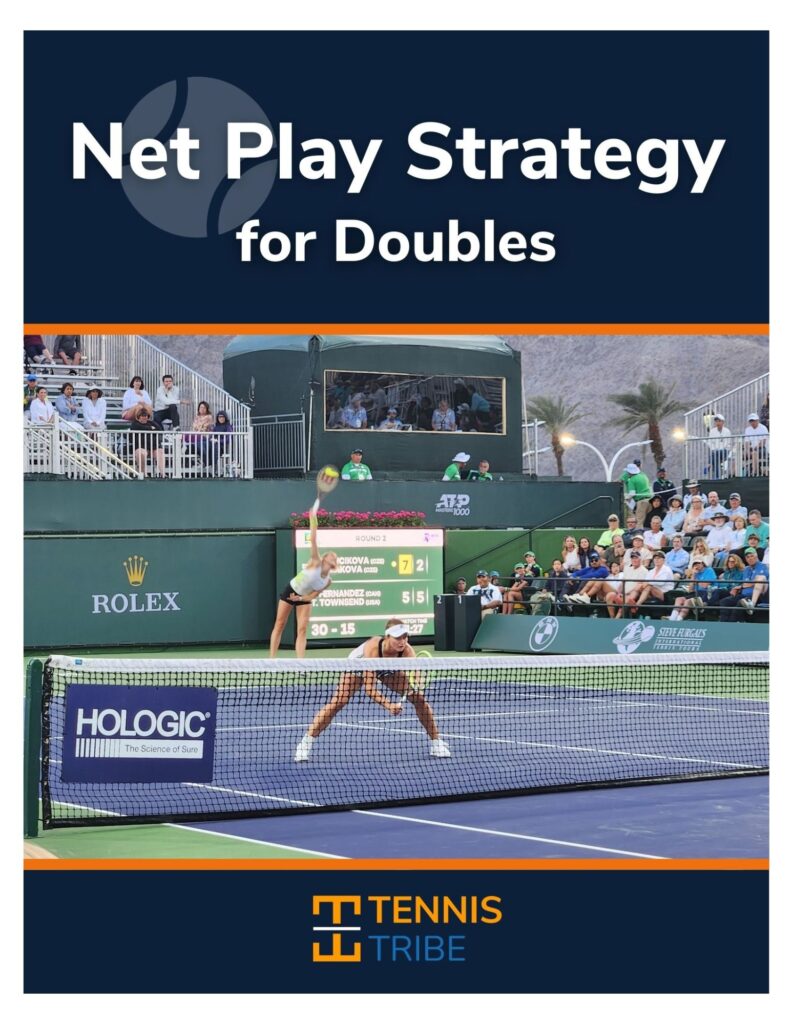
Great tips!
Thanks Robert!
Awesome tips! I’m a little confused about pinching, however. When does one start to move? Is the timing similar to poaching and you’re just not moving as far?
Thanks Dan!
The purpose of the pinch is to make the returner feel the pressure to hit a good return. You’re taking away some of the crosscourt shot from them, and you should be ready to cross if they float an easy ball for you to get. You’re also giving up a little bit of the doubles alley since it’s a low percentage shot.
The timing and aggressiveness of the pinch will vary depending on how good your partners serve is, where they hit their serve, and how good the returner is at hitting down the line.
Generally, you want to start moving forward as the serve crosses the net, then move a little towards the center net strap as the returner swings.
Does that make sense??
This video should help too –> https://youtu.be/fgNNGH7PSLo
That helps a lot, thanks!
Wow! Great tips and very clearly described and well structured approach. Excited to give this a go next dubs outing!
Thanks Bob!
Let me know how it goes in your next match. Good luck 🙂
The easiest way to win 4.0 and lower doubles is to lob ALL the time over the net player and drop shot/dink the player on the baseline. Think like a pusher! All STEADY, with no power groundstrokes. LOB, LOB, LOB, VOLLEY, SMASH!
Haha thanks Dan! The lob is a fantastic tactic in the right situation. I do think too many club-level players focus too much on power and miss as a result. I encourage players to add as many shots as possible to their games, including the lob and drop shot 🙂
Awesome
Thanks Abbas!
I have a big league match coming up so this is very helpful I have never done any of the above. I’m more of a singles player and I find myself timid at the net. I’m excited to try these tomorrow when we practice.
Awesome Jen!
Hope it helps with your league match 🙂
Hi Will,
I’m just returning to tennis after years away. In regards to net play what do you consider ‘fair game ‘ area to play at the ball. So I don’t infringe on my partners zone. I’ve seen shots go past me and thought I should have had a go.
Really appreciate your informative lessons.
Thanks, Roge (Australia )
Hey Roge, great question…
This is a tough topic because it depends on so many factors.
Who’s the better player between you and your partner? Who has the forehand volley in the middle? How good is the other team? How high & fast is the ball coming over the net?
I like to think about it by answering this question… which shot is the higher percentage shot for our team? Usually balls down the middle, for example, should be taken by the player with the forehand volley in the middle since forehand volleys are higher percentage shots. Or if I’m playing with a weaker partner, maybe I want to cover their side more.
Also, keep in mind that it’s sometimes good to poach at the net simply to let the opponent know that you’re there. Lateral movement at the net can force a lot of misses from the opponent.
Check out this lesson for more –> https://www.thetennistribe.com/poaching-in-tennis/
Hope that help 🙂
Great stuff, well said. Required reading for 3.0-4.0 doubles teams.
Thanks David!
Heading out for first match of the year so I’ll defo try these tactics
Fantastic blog
Thanks Blair! Hope it helps you win 🙂
Thanks for the tips. My question has to do with determining duece or ad court preferences. My backhand is so much better than forehand. People keep asking if I want forehand or backhand? What are they asking?
Hi Damon!
Backhand = Ad Court
Forehand = Deuce Court
People say this because typically you’ll hit more backhands in the ad court, and you’ll hit more forehands in the deuce court.
Most people prefer their forehand so it sounds like you have a competitive advantage there, and should play the ad side, aka the backhand side 🙂
Good luck!
The tips are simply explained and don’t over-verbalize as done in some lessons. Very practical and feasible to start using next time I play. Nicely done.
Thanks Kris!
Really enjoyed reading these and will review with my partner as we try to hone our doubles play. Do you ever travel to northeast, we’ve got a bunch of doubles groups that would love to buy you a beer or three 😉
Thanks John! I hope they help…
I don’t go to the northeast much, but follow the newsletter and you’ll know if I plan a tennis trip there 🙂
Will, seeing poachable balls go right by me where I lack the confidence to go for it is problem. Good partners, however, make it easier in all regards.
Hi George, this is a problem for a lot of doubles players.
I recommend trying some I-formation. This will force you to stand in the middle and be in a position to take any volley around the center net strap area.
You can also try poaching early and making the opponent change direction. This will force a lot of errors from the opponent.
Good luck!
Fantastic tips on movement at the net.
I usually pinch and need to practice the poaching more.
Great tips on when to start moving.
Thanks Janie! Yes, it’s important to use a lot of variety at the net with your movement to force errors from the other team.
Good luck
You made no comment about encouraging each other. I sometimes play with a partner who has absolutely no emotion on good plays and and on errors stares gloomy. It’s a really energy suck and frankly not fun to play with. Any tips there?
Hi Chris,
I wrote about being a good doubles partner here –> https://www.thetennistribe.com/good-doubles-partner/
I’m not sure that will fix your issues with the current partner… unless they read it 😉 May be time for a new partner
Love your doubles strategy & ideas. Difficult getting lower level partners to do this without sounding like a boss or know it all.
Great tips, well presented, orderly, what-when-where and how with whys.
Passing it along as a web site worth signing up for. Glen, Tampa, FL
Thank you Glen! I appreciate the support 🙂
Hi Will
Thank you for the great read, I will try to use them this weekend … stay safe
Johan Scheepers
Thanks Johan! I hope this helps you on the court 🙂
You asked for a comment on Pinching/faking. I am a low grade player playing 3-4 times a week. I find that by me constantly moving, opponents change their shots and make errors.
I jump up and down and pretend to move to the centre then come back to the side to cut off the pass. These two things get me 4-5 points per set. My friends “swear” at me in jest.
this really made me rethink how i play, ill practice these tips more often and see how we do in our matches, thank you for the tips.
Some great thoughts
This was very helpful and easy to understand for beginners. Thank you!!
Thanks Cathy!
Love the tips especially about not defending the line and faking. Good stuff. Going to look for more. Thanks.
Thanks Evin!
in our league poaching on the 2nd serve is usually a bad idea. i get beat down the line alot if i poach. also since most 2nd serves aren’t the fastest taking the serve early and on the raise almost elimates the poach because of the speed of the return. so i guess faking a poach might be the best strategy at that point. if u have a certain strategy u use on slower 2nd serves i’d like to hear it.
Good points… On 2nd serves it can be risky to poach. I like to do it a few times per match, but I’ll usually wait to move until the opponent is making contact with the ball. That way, they can’t change direction and beat me down the line.
If the returner is taking the 2nd serve early (from near the service line), then it may not be a good idea to poach at all on 2nd serves. If it’s a weaker serve, you’re in a defensive position and should try to force them to hit crosscourt to stay in the point.
Hope this helps!
Hi, I have a doubles match tomorrow and in my last match I missed quite a few shots that they hit through the tramline/ down the line. I was just wondering if you had any tips on how to stop this happening as if your opponents hit strong fats pace balls, I often find it difficult to cover the tramlines in time. Great tips though.
Thank you, Amelia
Hi Amelia,
If you’re getting passed down the doubles alley then the opponents are probably getting too many short balls. If your partner is in a crosscourt rally and isn’t hitting the ball deep enough, it will be easy to attack you down the alley.
You’ll want to cover the alley and force the opponent to hit crosscourt when they have a short, high forehand, for example. But it’s up to your partner to not give them that short ball.
Hope that helps. Good luck 🙂
How can you make sure faking actually works.
Hi Barrett, the goal of the fake is usually to force the opponent to change direction or try to hit a sharper angle. So the fake works if they try to hit down the line, or you force an error crosscourt. You want to use it in combination with pinching and poaching at net for maximum effectiveness.
this is a great little reminder. What if you have a woman partner who is not as strong and is not great at returning a fast return by a male player. Other than backing up or lobbing what can she do or what can i do as a partner to win more matches? BTW I sent her your article~!~!
David
4.5 player, California.
Thanks David! If you have a weaker partner, you have to cover more court and sometimes take more risks. It depends if they’re also the weakest on the court. In a lot of cases, you simply won’t break the guys serve, so you have to focus on the other games.
Here’s a video from a long time ago that is still applicable: https://youtu.be/opMHEyUjmYI
Hope this helps!
Is it a good or bad idea to tell your partner after he has played many flawless shots and misses one to advise him how to rectify his first blunder?
Hi Henri, you can do this but you have to be careful with your language. You do not want to coach them or try to correct tecnique during a match. Always use positive encouragement when providing advice as well. It is okay to tell them something like “It’s okay! We’ll get the next point. I think you’ve missed most of the serves in the net. Try aiming a little long. Just a small adjustment. You got this.”
I have a new course going on sale next Wednesday about this topic. Join the newsletter to get a discount 🙂